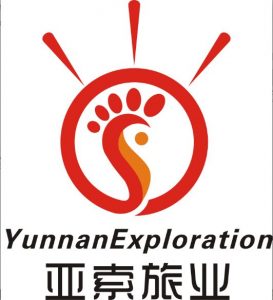
Lijiang Snow Mountain Sightseeing Train
Lijiang Snow Mountain Sightseeing Train (丽江雪山观光火车), also known as the “Lijiang Urban Rail Transit Line 1” (丽江轨道交通1号线), operates within Lijiang City, Yunnan Province, China. It is the first urban rail transit line in Lijiang and also China’s first snow mountain sightseeing train line. It officially opened for operation on February 12, 2025.
The train route runs from the Tourist Center Station in the south to the Yulong Snow Mountain Station in the north. It mainly follows the Limin Highway, connecting key tourist sites and popular spots like Baisha Ancient Town (白沙古镇), Yushui Village (玉水寨), Dongba Valley (东巴谷), and Gan Haizi (甘海子). This scenic train connects the UNESCO World Heritage Lijiang Old Town with the 5A-rated Yulong Snow Mountain National Scenic Area.
As of February 2024, the Lijiang Snow Mountain Sightseeing Train has a total of 5 stations, with 2 of them currently in operation. The line spans a length of 20.465 kilometers, with a design speed of 70 km/h.
Key Details:
Chinese Name: 丽江雪山观光火车 (Lijiang Snow Mountain Sightseeing Train)
Other Name: 丽江轨道交通1号线 (Lijiang Urban Rail Transit Line 1)
Opening Date: February 12, 2025
Operating Hours: 09:00–18:10
Track Type: Scenic Mountain Tourist Train
Route: Tourist Center Station to Yulong Snow Mountain Station
Total Length: 20.47 km (as of February 2025)
Number of Stations: 2 (as of February 2025)
Train Configuration: 3-car trains
Maximum Speed: 70 km/h
Operating Companies: Lijiang Snow Mountain Rail Transit Co., Ltd. and Guangzhou Metro Group Co., Ltd.
Historical Development:
The Lijiang Urban Rail Transit Line 1 project was awarded to a consortium in March 2019. The participating entities jointly founded the Lijiang Snow Mountain Rail Transit Co., Ltd. In July 2020, construction for the first phase of the project commenced. The first major construction milestone occurred in September 2021, with the completion of the vehicle base and the commencement of train assembly. By December 2021, the first train was delivered. By March 2022, the project successfully completed its initial testing phase, and by September 2023, it passed all safety assessments.
On February 12, 2025, the Lijiang Snow Mountain Sightseeing Train officially began operation, offering a scenic ride for tourists.

Stations:
During the initial phase of operation, visitors can travel between the starting and terminal stations. The intermediate stations will remain closed temporarily.
Stations:
Tourist Center Station (游客中心站) – Located in Baisha Town, Yulong County.
Baisha Ancient Town Station (白沙古镇站) – Not yet opened.
Yushui Village Station (玉水寨站) – Not yet opened.
Dongba Valley Station (东巴谷站) – Not yet opened.
Yulong Snow Mountain Station (玉龙雪山站) – Located at the Yulong Snow Mountain Scenic Area.
Operation and Timetable:
The sightseeing train operates at intervals of 12 minutes during its initial phase. The one-way trip takes approximately 35 minutes.
Timetable (February 12–18, 2025):
Tourist Center Station → Yulong Snow Mountain Station: 09:00, 09:30, 10:00, 10:30, 11:00, 11:30, 12:00, 12:30, 13:00, 13:30, 14:00, 14:30, 15:00, 15:30
Yulong Snow Mountain Station → Tourist Center Station: 10:10, 10:40, 11:10, 11:40, 12:10, 12:40, 13:10, 13:40, 14:10, 14:40, 15:10, 15:40, 16:10, 16:40, 17:10, 17:40, 18:10
Ticket Pricing and Discounts:
According to the “Yunnan Provincial Tourist Attraction Ticket Pricing Management Implementation Measures (Interim)” and related announcements, tickets for the Lijiang Snow Mountain Sightseeing Train during its initial phase will offer certain discounts.
Half-price Discounts:
Available for children aged 6–14 (excluding 6), children between 1.2 meters and 1.5 meters tall, active military personnel, fire rescue workers, and people with valid disability certificates.
Free Ticket Policy:
Available for children under 6 years old (inclusive), children under 1.2 meters tall (inclusive), and licensed tour guides with valid credentials.
Note: Entrance tickets to the Yulong Snow Mountain Scenic Area must be purchased separately. The snow mountain sightseeing train serves as one of the transportation options to the Yulong Snow Mountain Scenic Area, but the train ticket does not include the scenic area entry ticket.

Vehicle Facilities
The Lijiang Snow Mountain Sightseeing Train is designed with a maximum speed of 70 km/h and can carry up to 351 passengers. To adapt to the line’s unique features, including sharp curves and long slopes, the train introduces a powered articulated bogie, offering exceptional capability for towing on steep gradients. The side windows of the train are panoramic, using large 1.9-meter electric adjustable color-changing glass to shield passengers from high-altitude UV rays while offering a full scenic view. The vehicle is equipped with electric, hydraulic, and magnetic track braking systems, with sand-dispensing devices installed on each axle to ensure safe braking under extreme weather conditions like rain and snow or on continuous downhill tracks. The train features both first-class (business class) and second-class seating, catering to different passenger preferences.
Construction Achievements
Construction Challenges
The construction of the Lijiang Snow Mountain Sightseeing Train faced several challenges:
Ecological Protection at Yulong Snow Mountain: As a 5A-level tourist attraction, the area is subject to strict environmental conservation regulations.
Geological Complexity and High-altitude Construction: The region has complex geological structures, is located in an earthquake zone, and the high-altitude construction posed significant challenges.
Extreme Climate: The area experiences harsh high-altitude climates, making construction particularly difficult.
Innovative Construction Techniques: The project pioneered large-scale cable net wall installations in Lijiang, which presented significant technical challenges.
Solutions to Challenges
The Lijiang Snow Mountain Sightseeing Train overcame these challenges through various strategies:
Environmental Protection: A specialized environmental construction plan was developed to integrate ecological protection into the management system, ensuring strict adherence to design standards and safety measures.
Avoidance of Rare Plant Areas: The route was carefully planned to avoid areas with rare plants, and 23 wildlife migration channels were created to minimize ecological impacts.
Custom Machinery: Special machinery was designed to ensure that 4,000 track welds passed a 100% qualification rate in a single inspection, addressing the challenges of high-altitude and steep slope construction in mountainous regions.

Technological Innovations
During construction, several cutting-edge technologies were employed:
Seismic Isolation: A seismic isolation layer was added between the superstructure and foundation, and rubber seismic bearings were installed to reduce up to 80% of earthquake energy.
Cable Net Glass Curtain Wall: A cable net glass curtain wall construction technique was used at the northern entrance of the visitor center.
Wind Resistance System: The train uses orthogonal bidirectional single-cable systems with different diameters to create a wind resistance framework.
Honors and Awards
Throughout its construction, the Lijiang Snow Mountain Sightseeing Train project received several awards:
August 30, 2022: The project won the 2021 China Traffic Investment and Financing Annual Innovation Project Award (Second Prize).
2024: The project was awarded the 2024 China Railway Construction Cup Quality Engineering Award.
Cultural Characteristics
Vehicle Design
The Lijiang Snow Mountain Sightseeing Train’s exterior features a design inspired by the “Sky Mirror,” with a large curved front window and a dreamy blue color inspired by Lijiang’s Blue Moon Lake. The interior features a unique suspended ceiling design and an arch-shaped structure on the side panels, complementing the panoramic windows. The decoration style incorporates elements of Lijiang’s Dongba culture and Naxi ethnic art, reflecting the natural and cultural heritage of Lijiang. The seats are upholstered in traditional Naxi Le Baba fabric, blending aesthetics with comfort.
Value and Significance
The Lijiang Urban Rail Transit Line 1 project is one of Yunnan Province’s key “Four Hundred” projects and the first urban rail transit line in Lijiang. Its operation is crucial for enhancing the city’s infrastructure and expanding the tourism capacity at Yulong Snow Mountain. The opening of the Lijiang Snow Mountain Sightseeing Train has provided tourists with a unique, close-up view of Yulong Snow Mountain’s scenic beauty, significantly enhancing the quality of tourism in Lijiang and its global brand. It also promotes the development of tourism services and related industries along the route, helping Lijiang in its quest to become a world-class cultural and tourism city.
By connecting major attractions such as the Yulong Snow Mountain Visitor Center, Baisha Ancient Town (白沙古镇), Yushui Village (玉水寨), Dongba Valley (东巴谷), and Gan Haizi (甘海子), the train enhances the travel experience and aids in the sustainable development of both tourism and environmental protection in the region.
Connecting Lijiang Old Town and Yulong Snow Mountain
The Lijiang Snow Mountain Sightseeing Train is a pivotal link between the World Heritage-listed Lijiang Old Town and the 5A-rated Yulong Snow Mountain. The train combines the rich traditional culture of Lijiang with its stunning natural scenery, providing a special transportation option for tourists. It is the first fully panoramic sightseeing mountain tourist train in the world, helping build Lijiang’s “Fast Travel, Slow Travel” rail network and taking a historic step in improving the city’s tourism quality.
The opening of this unique sightseeing line has not only brought a new energy to Lijiang’s tourism sector but also supported its economic development by creating more job opportunities and enhancing the local culture. It serves as a platform for promoting the history, culture, and customs of the Naxi people to a wider audience.

 7 Days GolfingTour
7 Days GolfingTour
 8 Days Group Tour
8 Days Group Tour
 8 Days Yunnan Tour
8 Days Yunnan Tour
 7 Days Shangri La Hiking
7 Days Shangri La Hiking
 11 Days Yunnan Tour
11 Days Yunnan Tour
 6 Days Yuanyang Terraces
6 Days Yuanyang Terraces
 11 Days Yunnan Tour
11 Days Yunnan Tour
 8 Days South Yunnan
8 Days South Yunnan
 7 Days Tea Tour
7 Days Tea Tour
 8 Days Muslim Tour
8 Days Muslim Tour
 12 Days Self-Driving
12 Days Self-Driving
 4 Days Haba Climbing
4 Days Haba Climbing
 Tiger Leaping Gorge
Tiger Leaping Gorge
 Stone Forest
Stone Forest
 Yunnan-Tibet
Yunnan-Tibet
 Hani Rice Terraces
Hani Rice Terraces
 Kunming
Kunming
 Lijiang
Lijiang
 Shangri-la
Shangri-la
 Dali
Dali
 XishuangBanna
XishuangBanna
 Honghe
Honghe
 Kunming
Kunming
 Lijiang
Lijiang
 Shangri-la
Shangri-la
 Yuanyang Rice Terraces
Yuanyang Rice Terraces
 Nujiang
Nujiang
 XishuangBanna
XishuangBanna
 Spring City Golf
Spring City Golf
 Snow Mountain Golf
Snow Mountain Golf
 Stone Mountain Golf
Stone Mountain Golf











